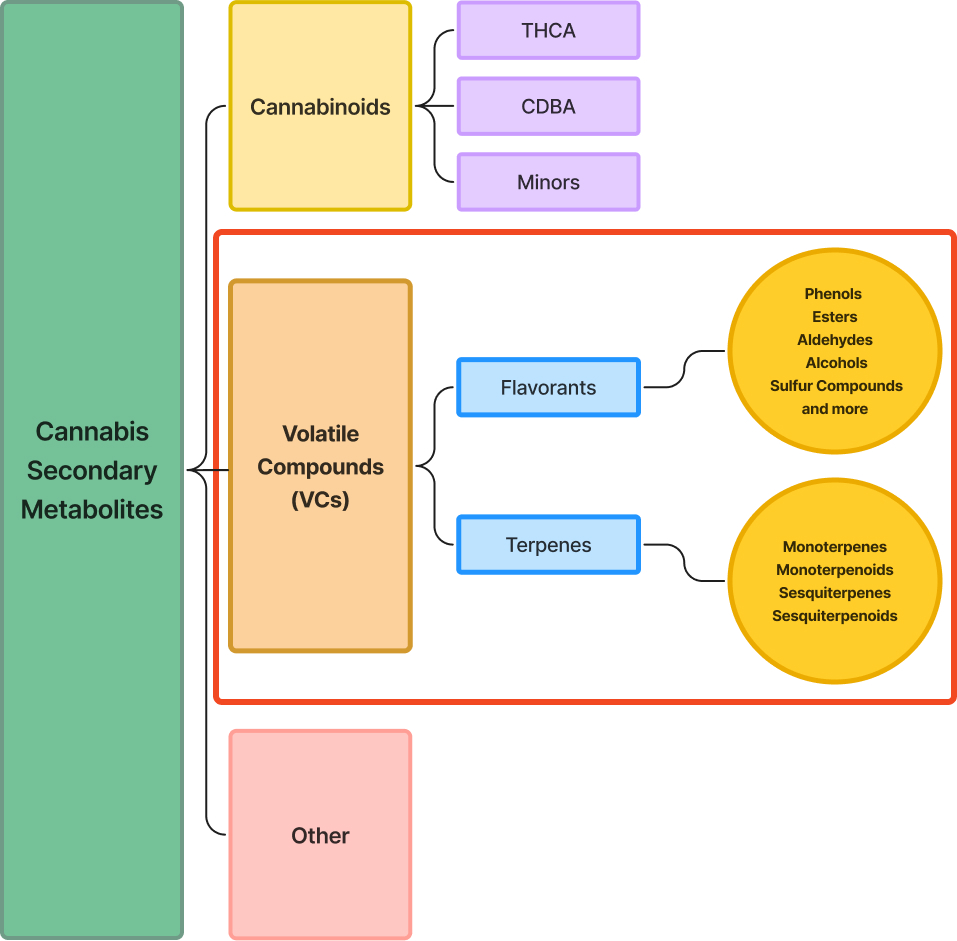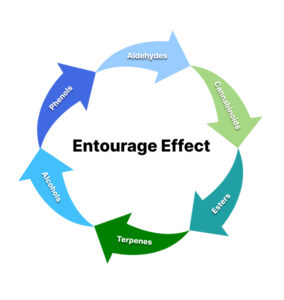How Temperature Impacts Terpenes and Volatile Compounds
Understanding vaporescent molecules and how temperature affects the sensory profiles of cannabis flower, concentrates, and vapes
by Jeff Wu - December 13, 2024
Learn about the molecular makeup of cannabis, how temperature affects its secondary metabolites, and common melting points for terpenes and flavorants
Why Preserve Terpenes and Volatile Compounds
Understanding terpenes and other types of cannabis secondary metabolites and how they contribute to the sensory experience is fundamental in preserving product quality
Learning how temperature affects vaporescent molecules and what temperature do terpenes evaporate helps to determine handling, storing, and processing techniques and environments
Identifying interactions between sensitive volatile compounds in cannabis is essential in maintaining the natural aromas and flavors of the product
What are Volatile Compounds
Being comprised of over 6000 chemical compounds, one could say that cannabis is a complex crop. Of these molecules, volatile compounds (VCs) are one of the major classes of secondary metabolites (Figure 1). VCs contain two key categories: flavorants and terpenes. These two non-cannabinoid components contribute to the sensory profiles of cannabis, including a strain’s distinct aroma, flavor notes, and color. Both VCs can be further categorized based on their chemical functionality (Figure 1). Phenols, esters, aldehydes, alcohols, sulfur compounds (thiols), and more chemicals are among the subclasses of flavorants, while four subclasses of terpenes exist: monoterpenes, monoterpenoids, sesquiterpenes, sesquiterpenoids.

Figure 1: Bracket Chart of Cannabis Secondary Metabolites. Focusing on the volatile compounds category with classes of VCs are outlined in the red box.
Why are Volatile Compounds Challenging to Preserve
As their name suggests, volatile compounds are delicate constituents of cannabis. Their molecular compositions and structures make them vaporescent within their immediate surroundings, meaning they evaporate easily, making them difficult to preserve. VCs are released from the plant and flower and act as signals to communicate with animals, other plants, and the environment unlike the phytocannabinoids, THC and CBD. Cannabis VCs are highly likely to vaporize and are released into the air as gas when factors such as light, oxygen, pressure, and temperature change around them during grow, processing, chemical analysis, manufacturing, and consumption. Cannabis VCs work in the same way that other plants, perfumes, and incense do. If you can detect the smell of flower, a concentrate, or vape, those aromas are VCs evaporating and being emitted into the surrounding space.
How Does Temperature Influence Volatile Compounds
Additionally, these heat sensitive molecules can be chemically altered or completely destroyed by high temperatures. There are many VCs that will begin to volatilize, or evaporate, at ambient conditions. Some VC’s can start degrading at temperatures as low as 21 °C (70 °F). When certain VCs evaporate, this can alter the chemical composition, aromatics, and flavor profiles of the other VCs in the product. Any significant rise in temperature in the environment around flower or concentrates could cause VCs to “burn off” and be lost from the product. It is important to protect volatile compounds and terpenes to retain the unique properties and overall experience.
To preserve these scent, taste, and effects of cannabis terpenes and flavorants, handle and work with product at cooler (below 21 °C (70 °F)) and storage (between (1 – 4°C (36 – 40°F)) temperatures. If VCs are not taken into consideration or handled appropriately, they could degrade, which results in a low quality and less effective product.
What Temperature do Terpenes Evaporate
Although this is not an extensive list, the table below displays some common volatile compounds, their aroma profiles, and boiling points. Each VC’s melting point depends on its molecular size, meaning that larger molecules have higher degradation temperatures and evaporate slower than smaller compounds. This illustrates that it is important to handle, store, process, and manufacture cannabis products, especially concentrates and oils for vapes, below these thresholds to conserve the compounds that give strains and concentrates their distinct characteristics.
Table 1. Common Cannabis Volatile Compounds Boiling Points
How Do Volatile Compounds Work
Furthermore, the theory of how VCs function is relatively new, but cannabis researchers have coined the term “The Entourage Effect” (Figure 2). The entourage effect is used to describe how the molecular constituents of cannabis function in cohesion or work together. It is a common misconception that terpenes are the only bioactive compounds responsible for the aroma and flavor profiles of cannabis. This new-found theory implies that there is much more coaction or compounding interaction between cannabinoids and volatile compounds. When these molecules work in synergy, they all contribute to and influence the smell, mouth and throat-feel, flavor, psychoactive effects, and other distinctive notes of the product. Keeping these vaporescent compounds intact through temperature control and careful handling will provide for the highest achievable product quality and effects.

Final Thougths
It is imperative to understand the molecular makeup of cannabis and how these chemical compounds function individually and collectively. Cannabis volatile compounds are delicate and unique, and applying temperature control during handling, storage, processing, manufacturing protects these naturally occurring molecules from degrading and dampening the consumer experience.

Jeff Wu
Technical Director
Investor & entrepreneur, bringing a unique blend of scientific knowledge and hands-on experience in pharma, laboratory, manufacturing, and cannabis. Deep understanding of chemistry, electronics manufacturing, automation, and cannabis processing.

